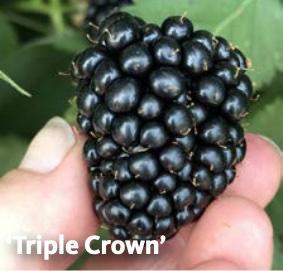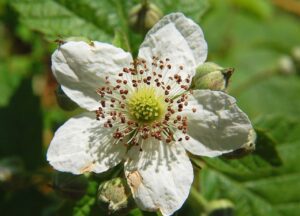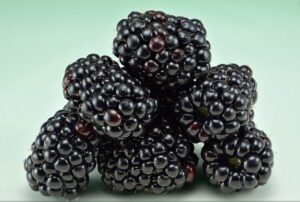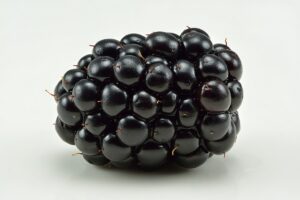Triple Crown Thornless Blackberry
by: Oriana Kruszewski
From Grapevine, Sept. 2003

In 1999, North American Fruit Explorers held its annual conference at Urban-Champaign, Illinois. we had a chance to tour the University of Illinois orchard. We came across a blackberry patch where we tasted many varieties of blackberries. One of these was very sweet. We were told it was “Triple Crown” thornless blackberry. That was the first time I tasted this variety and I was very impressed by it. The following spring, I planted a dozen of them as certified disease-free stock and waited to taste the berry again. This is now the 3rd season, the canes grew into a huge patch, which is nothing like those plants we saw in Champaign. The canes can extend to ten feet or longer if not pruned. Strong canes are about 1″ in diameter. The last two winters were mild, so only a couple of canes had winter damage. The fruits are loaded on each cane. The berries are as large as 1-1/2″ long. Some are sweet and some are tart, depending on where and when you pick them.
The root of the blackberry plant is perennial, but the canes are biannual. Right now (August 4) this year’s canes are pruned to 5 feet , the lateral branches almost reach 20 inches which I should prune to 12 inches in late winter or spring. The flowers are borne far out on the ends of the laterals so do not cut back too far. I pulled all the young canes to one side of the patch, the less sunny side so the old canes, which are loaded with berries, will stay on the sunny side of the patch. As soon as all the berries are picked, I cut last year’s canes near the ground. Do not put old canes to your compost pile, they will root there. After pruning, pull those young canes back straight, as ample light is important to develop good fruit set for the next season. It is hard to believe that the hot sunny days affect the taste of the berry, that is the only reason I love the 90 degree days this summer. I find that berries picked from the top of the plant are much sweeter than those lower down on the canes. I learned how to select which berry is really ready to be picked, when the tiny fruitlets, called druplets, separated from each other and, with a gentle pull comes off. These are ripe, dead ripe. The blackberry fruit doesn’t part ways with the receptacle like the raspberry. I always carry two containers with me when I go to the berry patch, one container for those that are perfect for fresh eating, and the other for cooking purposes. They do not keep well; they lose color after a day or two in refrigerator.
Thornless blackberries propagate by tip layering, so I let some of the canes grow long and touching the ground late in the season. Roots grow from these tips. In the spring, cut off the tip, leave few inches of branch stub and dig up the new plant. You can also dig up root suckers and move them to a new location. Remove suckers no closer than 6″ from the mother plant and dig deeply so you’re sure to get them out intact. Suckers come up badly if the main crown is damaged. I also find a lot of young seedlings come up around my vegetable plot. I think they are from the damaged berries I threw away or that were dropped by the birds, so this year I will be more careful where I discard the bad ones. I should pull out all those seedlings to avoid spreading of viruses or diseases, but I am curious whether or not these seedlings will be thornless. Brambles are relatively trouble-free plants. To keep down weeds, only allow 5 or 6 canes per crown, quickly remove any sick-looking canes. Various species of borers can infest the canes, but if you cut out and dispose of any wilted canes right away, this should help to avoid pest trouble.
Four out of the 12 plants I bought were planted in Skokie yard, the rest were planted in my zone 4b farm in Winslow, Illinois for a trial. So far I have harvested about 20 pounds of ripe berries from the Skokie plants, about half of the berries are still hanging on the canes. It is very productive. I mainly use these for juice and jellies. Not as flavorful as raspberry, it is healthy material and easier to grow than any tree fruit. It is a pleasure to pick them.
__________________________________________________________________________________
Blackberry


Extracted from:
https://en.wikipedia.org/wiki/Blackberry
The blackberry is an edible fruit produced by many species in the genus Rubus in the family Rosaceae, hybrids among these species within the subgenus Rubus, and hybrids between the subgenera Rubus and Idaeobatus. The taxonomy of blackberries has historically been confused because of hybridization and apomixis, so that species have often been grouped together and called species aggregates.
Description
What distinguishes the blackberry from its raspberry relatives is whether or not the torus (receptacle or stem) “picks with” (i.e., stays with) the fruit. When picking a blackberry fruit, the torus stays with the fruit. With a raspberry, the torus remains on the plant, leaving a hollow core in the raspberry fruit.[4]
The usually black fruit is not a berry in the botanical sense, as it is termed botanically as an aggregate fruit, composed of small drupelets. It is a widespread and well-known group of over 375 species, many of which are closely related apomictic microspecies native throughout Europe, northwestern Africa, temperate western and central Asia and North and South America.[7]
Plants
Second-year flowering, fruiting floricanes to the left. First-year primocanes without flowers or fruit growing on the right. Blackberries are perennial plants bearing biennial stems (called canes) from their roots.[8. In its first year, a new stem, the primocane, reaches a full length of about 3–6 metres (9.8–19.7 feet) trailing on the ground and bearing large palmate compound leaves with 5–7 new leaves; it does not produce any flowers.[8] In its second year, the cane is a floricane with a non-growing stem.[8] The lateral buds open to produce flowering laterals.[8] First- and second-year shoots produce short-curved, sharp thorns.[8] Thornless cultivars have been developed during the early 21st century.[8][9]
History
Modern hybridization and cultivar development took place mostly in the US. In 1880, a hybrid blackberry-raspberry named the loganberry was developed in Santa Cruz, California, by an American judge and horticulturalist, James Harvey Logan. One of the first thornless varieties was developed in 1921, but the berries lost much of their flavor. Common thornless cultivars developed from the 1990s to the early 21st century by the US Department of Agriculture enabled efficient machine-harvesting, higher yields, larger and firmer fruit, and improved flavor, including the Triple Crown,[21][22] Black Diamond, Black Pearl, and Nightfall, a marionberry.[9]
Thornless
Semi-erect, prickle-free blackberries were first developed at the John Innes Centrein Norwich, UK, and subsequently by the USDA-ARS in Beltsville, Maryland. These are crown forming and very vigorous and need a trellis for support. Cultivars include ‘Black Satin’, ‘Chester Thornless’, ‘Dirksen Thornless’, ‘Hull Thornless’, ‘Loch Maree’, ‘Loch Ness’, ‘Loch Tay’, ‘Merton Thornless’, ‘Smoothstem’, and ‘Triple Crown’.[24] ‘Loch Ness’ and ‘Loch Tay’ have gained the RHS’s Award of Garden Merit.[25] The cultivar ‘Cacanska Bestrna‘ (also called ‘Cacak Thornless’) has been developed in Serbia and has been planted on many thousands of hectares there.
Primocane
In raspberries, these types are called primocane fruiting, fall fruiting, or everbearing. ‘Prime-Jim’ and ‘Prime-Jan’ were released in 2004 by the University of Arkansas and are the first cultivars of primocane fruiting blackberry.[28] They grow much like the other erect cultivars, however, the canes that emerge in the spring will flower in midsummer and fruit in late summer or fall. The fall crop has its highest quality when it ripens in cool mild climate such as in California or the Pacific Northwest.[29].
‘Illini Hardy’, a semi-erect prickly cultivar introduced by the University of Illinois, is cane hardy in zone 5, where blackberry production has traditionally been problematic, since canes often failed to survive the winter.

Further details about blackberries and the references cited above can be seen at: